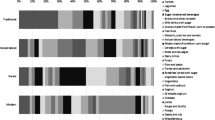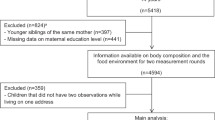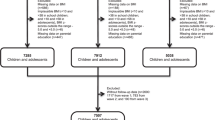Abstract
Purpose
The aims of this study were (1) to identify the different food consumption patterns among Spanish preschoolers and (2) to examine the association between having a different food consumption pattern and the odds of having excess weight (i.e., overweight or obesity) or obesity among this population.
Methods
This was a nationwide cross-sectional study with data from the Spanish National Health Survey−2017. All preschoolers (aged 3−5 years) with complete information on all the variables analyzed were selected. The frequency of consumption of the fourteen food groups was evaluated by a food frequency questionnaire. Excess weight/obesity were computed following the World Health Organization criteria. A hierarchical cluster analysis using Ward’s method (i.e., based on squared Euclidean distances) and k-means were performed including all food group consumption. A total sample of 663 was included in the cluster analysis.
Results
Three different clusters were established. Compared to the healthiest food consumption pattern (Cluster 1), higher odds of excess weight (OR = 1.51; CI: 95%, 1.02–2.25) and obesity (OR = 1.59; CI: 95%, 1.01–2.51) were found for participants with the unhealthiest food consumption pattern (Cluster 3).
Conclusion
Having a food consumption pattern considered unhealthy (i.e., low intake of vegetables/fruits, high consumption of confectionery products, sugar-sweetened beverages, fast-food, and snacks) was associated with presenting excess weight/obesity among Spanish preschoolers.
Impact
-
No studies have examined the specific food consumption patterns associated with excess weight or obesity among Spanish preschoolers.
-
The unhealthiest food consumption pattern was characterized by a food consumption pattern that included a lower intake of vegetables and fruits and a higher consumption of confectionery products, sugar-sweetened beverages, fast-food, and snacks.
-
Having a food consumption pattern considered unhealthy was associated with a higher prevalence of excess weight and obesity in comparison with other healthier food consumption patterns.
This is a preview of subscription content, access via your institution
Access options
Subscribe to this journal
Receive 14 print issues and online access
$259.00 per year
only $18.50 per issue
Buy this article
- Purchase on Springer Link
- Instant access to full article PDF
Prices may be subject to local taxes which are calculated during checkout


Similar content being viewed by others
Data availability
The datasets generated during and/or analyzed during the current study are available in the Ministry of Health, Consumer Affairs and Social Welfare (Spain) repository, https://www.sanidad.gob.es/estadisticas/microdatos.do.
References
Abarca-Gómez, L. et al. Worldwide trends in body-mass index, underweight, overweight, and obesity from 1975 to 2016: a pooled analysis of 2416 population-based measurement studies in 128·9 million children, adolescents, and adults. Lancet 390, 2627–2642 (2017).
World Health Organization. Global nutrition targets 2025: childhood overweight policy brief (WHO/NMH/NHD/14.6) [Internet]. Geneva, Switzerland: 2014. Available from: https://apps.who.int/iris/bitstream/handle/10665/149021/WHO_NMH_NHD_14.6_eng.pdf?ua=1.
Estudio ALADINO 2019. Estudio sobre Alimentación, Actividad Física, Desarrollo Infantil y Obesidad en España 2019 [Internet]. Madrid, Spain: Agencia Española de Seguridad Alimentaria y Nutrición (Ministerio de Consumo); 2020. Available from: https://www.aesan.gob.es/AECOSAN/docs/documentos/nutricion/observatorio/Informe_Aladino_2019.pdf.
de Onis, M. Development of a WHO growth reference for school-aged children and adolescents. Bull. World Health Organ 85, 660–667 (2007).
de Bont, J., Bennett, M., León-Muñoz, L. M. & Duarte-Salles, T. Prevalencia e incidencia de sobrepeso y obesidad en 2,5 millones de niños y adolescentes en España. Rev. Esp. Cardiol. 75, 300–307 (2022).
Mahase, E. Obesity: No European country is on track to halt rising levels by 2025, WHO warns. BMJ 377, o1107 (2022).
World Health Organization. Healthy diet [Internet]. Geneva, Switzerland: 2020. Available from: https://www.who.int/news-room/fact-sheets/detail/healthy-diet.
Afshin, A. et al. Health effects of dietary risks in 195 countries, 1990–2017: a systematic analysis for the Global Burden of Disease Study 2017. Lancet 393, 1958–1972 (2019).
Gakidou, E. et al. Global, regional, and national comparative risk assessment of 84 behavioural, environmental and occupational, and metabolic risks or clusters of risks, 1990–2016: a systematic analysis for the Global Burden of Disease Study 2016. Lancet 390, 1345–1422 (2017).
World Health Organization. Global Action Plan for the Prevention and Control of NCDs 2013–2020 [Internet]. Geneva, Switzerland: 2015. Available from: http://www.who.int/nmh/events/ncd_action_plan/en/.
Liberali, R., Kupek, E. & Assis, M. A. A. Dietary patterns and childhood obesity risk: a systematic review. Child Obes. 16, 70–85 (2020).
Liberali, R., Del Castanhel, F., Kupek, E. & Assis, M. A. Ade Latent class analysis of lifestyle risk factors and association with overweight and/or obesity in children and adolescents: systematic review. Child Obes. 17, 2–15 (2021).
Rutayisire, E. et al. Dietary patterns are not associated with overweight and obesity in a sample of 8900 Chinese preschool children from four cities. J. Nutr. Sci. 7, e24 (2018).
Nasreddine, L. et al. A traditional dietary pattern is associated with lower odds of overweight and obesity among preschool children in Lebanon: a cross-sectional study. Eur. J. Nutr. 58, 91–102 (2019).
Choy, C. C. et al. Dietary patterns are associated with child, maternal and household-level characteristics and overweight/obesity among young Samoan children. Public Health Nutr. 21, 1243–54. (2018).
Shi, Z., Makrides, M. & Zhou, S. J. Dietary patterns and obesity in preschool children in Australia: a cross-sectional study. Asia Pac. J. Clin. Nutr. 27, 406–412 (2018).
Nobre LN, Lamounier JA, Franceschini SC. Preschool children dietary patterns and associated factors. J Pediatr (Rio J). 88, 129–36 (2012).
Ambrosini, G. L. Childhood dietary patterns and later obesity: a review of the evidence. Proc. Nutr. Soc. 73, 137–146 (2014).
Plaza-Díaz, J. et al. Clustering of dietary patterns and lifestyles among Spanish children in the EsNuPI study †. Nutrients 12, 2536 (2020).
Pérez-Rodrigo, C. et al. Clustering of dietary patterns, lifestyles, and overweight among Spanish children and adolescents in the ANIBES study. Nutrients 8, 11 (2015).
Bodega, P. et al. Dietary patterns and cardiovascular risk factors in Spanish adolescents: a cross-sectional analysis of the SI! program for health promotion in secondary schools. Nutrients 11, 2297 (2019).
Lanigan, J., Barber, S. & Singhal, A. Prevention of obesity in preschool children. Proc. Nutr. Soc. 69, 204–210 (2010).
Ministry of Health, Consumer Affairs and Social Welfare. Spanish National Health Survey [Internet]. Madrid, Spain: 2018. Available from: https://www.mscbs.gob.es/estadEstudios/estadisticas/encuestaNacional/encuestaNac2017/ENSE17_MOD3_REL.pdf.
National Statistics Institute. National Health Survey. Results [Internet]. Madrid, España: 2018. Available from: https://www.ine.es/dyngs/INEbase/es/operacion.htm?c=Estadistica_C&cid=1254736176783&menu=resultados&idp=1254735573175#!tabs-1254736195650.
Roman-Viñas, B. et al. International Physical Activity Questionnaire: Reliability and validity in a Spanish population. Eur. J. Sport Sci. 10, 297–304 (2010).
López-Gil, J. F., Brazo-Sayavera, J., García-Hermoso, A., de Camargo, E. M. & Yuste Lucas, J. L. Clustering patterns of physical fitness, physical activity, sedentary, and dietary behavior among school children. Child Obes. 16, 564–570 (2020).
Steinley, D. & Brusco, M. J. Evaluating mixture modeling for clustering: Recommendations and cautions. Psychol. Methods 16, 63–79 (2011).
Garrido-Miguel et al. Prevalence of overweight and obesity among European preschool children: a systematic review and meta-regression by food group consumption. Nutrients 11, 1698 (2019).
de Graaf, C. Texture and satiation: The role of oro-sensory exposure time. Physiol. Behav. 107, 496–501 (2012).
Poorolajal, J., Sahraei, F., Mohamdadi, Y., Doosti-Irani, A. & Moradi, L. Behavioral factors influencing childhood obesity: a systematic review and meta-analysis. Obes. Res Clin. Pr. 14, 109–118 (2020).
Cardon, G. et al. Health related behaviours in normal weight and overweight preschoolers of a large pan-European sample: the toybox-study. PLoS One 11, e0150580 (2016).
Min, K. et al. Dietary patterns and their associations with overweight/obesity among preschool children in Dongcheng District of Beijing: a cross-sectional study. BMC Public Health 21, 223 (2021).
Monteiro, C. A. et al. The UN Decade of Nutrition, the NOVA food classification and the trouble with ultra-processing. Public Health Nutr. 21, 5–17 (2018).
García-Blanco, L., et al. Individual and family predictors of ultra-processed food consumption in Spanish children. The SENDO project. Public Health Nutr. 1–22 https://www.cambridge.org/core/services/aop-cambridgecore/content/view/2A9B050BB987989B0A78BA83AFF8EF34/S136898002200132Xa.pdf/individual-and-familypredictors-of-ultra-processed-food-consumption-in-spanish-children-the-sendo-project.pdf (2022).
Sirkka, O. et al. Dietary patterns in early childhood and the risk of childhood overweight: the GECKO drenthe birth cohort. Nutrients 13, 2046 (2021).
Hall, K. D. et al. Ultra-processed diets cause excess calorie intake and weight gain: an inpatient randomized controlled trial of ad libitum food intake. Cell Metab. 30, 226 (2019).
Kumar, S. & Kelly, A. S. Review of childhood obesity: from epidemiology, etiology, and comorbidities to clinical assessment and treatment. Mayo Clin. Proc. 92, 251–265 (2017).
Erlanson-Albertsson, C. How palatable food disrupts appetite regulation. Basic Clin. Phaymacol. Toxicol. 97, 61–73 (2005).
Pereira-da-Silva, L., Rêgo, C. & Pietrobelli, A. The diet of preschool children in the mediterranean countries of the European union: a systematic review. Int J. Environ. Res Public Health 13, 572 (2016).
Rollo, S., Antsygina, O. & Tremblay, M. S. The whole day matters: Understanding 24-hour movement guideline adherence and relationships with health indicators across the lifespan. J. Sport Health Sci. 9, 493–510 (2020).
Tapia-Serrano, M. A. et al. Prevalence of meeting 24-hour movement guidelines from pre-school to adolescence: A systematic review and meta-analysis including 387,437 participants and 23 countries. J. Sport Health Sci. 11, 427–437 (2022).
López‐Gil, J. F., Roman‐Viñas, B., Aznar, S. & Tremblay, M. S. Meeting 24‐h movement guidelines: Prevalence, correlates, and associations with socioemotional behavior in Spanish minors. Scand. J. Med. Sci. Sports 32, 881–891 (2022).
Martínez-Martínez, M. I., Alegre-Martínez, A. & Cauli, O. Omega-3 long-chain polyunsaturated fatty acids intake in children: the role of family-related social determinants. Nutrients 12, 3455 (2020).
Heitmann, B. L. & Lissner, L. Dietary underreporting by obese individuals–is it specific or non-specific? BMJ 311, 986–989 (1995).
Blaine, R. E., Kachurak, A., Davison, K. K., Klabunde, R. & Fisher, J. O. Food parenting and child snacking: a systematic review. Int J. Behav. Nutr. Phys. Act. 14, 146 (2017).
Shloim, N., Edelson, L. R., Martin, N. & Hetherington, M. M. Parenting Styles, Feeding Styles, Feeding Practices, and Weight Status in 4-12 Year-Old Children: A Systematic Review of the Literature. Front Psychol. 6, 1849 (2015).
Acknowledgements
J.F.L.-G is a Margarita Salas Fellow (Universidad de Castilla-La Mancha—2021-MS-20563).
Author information
Authors and Affiliations
Contributions
Conceptualization, methodology, software, validation, analysis, data curation, writing—original draft preparation: J.F.L.-G., supervision: J.F.L.-G., P.J.T.-L., writing—review and editing: L.E., J.A.-H., J.A.-A., J.M.P.R., H.G.-E., R.L.-B., and P.J.T.-L. All authors have read and agreed to the published version of the manuscript.
Corresponding author
Ethics declarations
Competing interests
The authors declare no competing interests.
Additional information
Publisher’s note Springer Nature remains neutral with regard to jurisdictional claims in published maps and institutional affiliations.
Supplementary information
Rights and permissions
Springer Nature or its licensor (e.g. a society or other partner) holds exclusive rights to this article under a publishing agreement with the author(s) or other rightsholder(s); author self-archiving of the accepted manuscript version of this article is solely governed by the terms of such publishing agreement and applicable law.
About this article
Cite this article
López-Gil, J.F., Smith, L., Abellán-Huerta, J. et al. Food consumption patterns related to excess weight and obesity in Spanish preschoolers. Pediatr Res 94, 385–391 (2023). https://doi.org/10.1038/s41390-022-02442-9
Received:
Revised:
Accepted:
Published:
Issue Date:
DOI: https://doi.org/10.1038/s41390-022-02442-9



